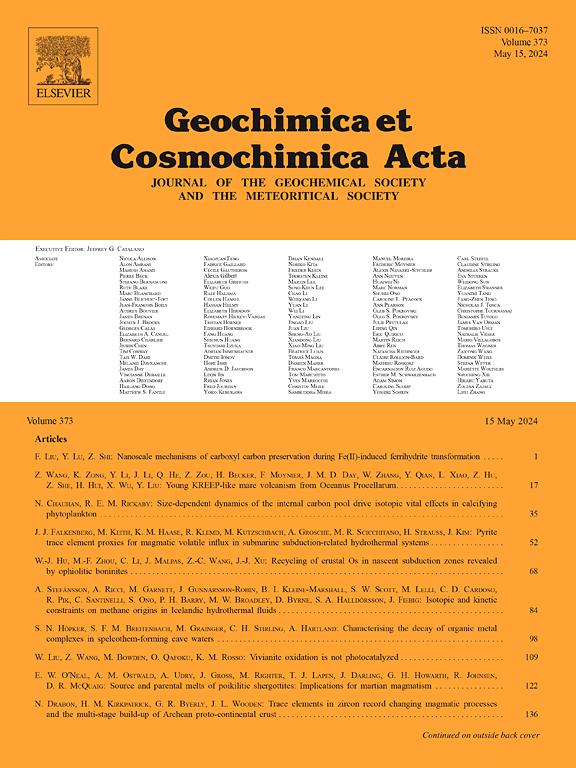研究来自黄石火山羽流的热量对地壳氦释放的影响
IF 5
1区 地球科学
Q1 GEOCHEMISTRY & GEOPHYSICS
引用次数: 0
摘要
氦(He)是一种不可替代的资源,在低碳技术、医疗应用以及各种科学和工程领域都是不可替代的资源,目前正在作为一种初级资源进行开发。在某些地质环境(如洋中脊和大陆热液系统)中,地壳氦释放与热流之间的相关性已经建立,但很少有研究评估过去的火成岩过程如何影响当前地壳岩石中的气体释放/储存。在这里,我们报告了从美国黄石国家公园(YNP)及其周围的温泉中收集的大宗天然气和稀有气体地球化学数据(n = 43)。YNP外(靠近羽流轨迹)的样品主要富含n2,而在活跃破火山口区域内收集的大多数样品富含co2。YNP外样品的3He/4He通常比破火山口内(即靠近当前羽头)的样品低得多。我们利用热流数据结合大宗气体和稀有气体地球化学数据,探讨了热光环与He同位素特征之间的关系。数据用于确定气体来源,了解区域背景下的流体流动情况,并评估不同环境如何影响地壳矿物中He的释放。模型表明,平流是控制从黄石火山口到地壳系统的热量和挥发性损失的主要过程。相比之下,地壳热液流体的传导/沸腾对黄石火山口外样品的影响更大。氦-4在锋面和靠近喷发中心的样品中富集,可能是由于下伏克拉通长期积累的氦-4最近的地壳脱气所致。最终,由于构造活动,He和其他挥发物被释放出来,并且/或者当其他气体从地下水中分离出来(即从地下水中剥离气体)时,它们被富集。然而,高热流区可能构成较差的He保留区。我们提出了两种方法来帮助确定He释放的优先区域:1)关注远离活动火成岩带的区域(即尚未完全脱气的区域),局部适度热流释放被捕获的地壳He; 2)利用同位素模型来约束地下水相互作用(即迁移和聚集潜力)。本文章由计算机程序翻译,如有差异,请以英文原文为准。
Examining the Effect of Heat from the Yellowstone Plume on the Release of Helium from the Crust
Helium (He), which is an irreplaceable resource in low-carbon technologies, medical applications, and various science and engineering sectors, is currently being explored as a primary resource. The correlation between crustal helium (He) release and heat flow in certain geologic environments (e.g., mid-ocean ridge and continental hydrothermal systems) is well established, but few studies have evaluated how past igneous processes influence current gas release/storage from crustal rocks. Here, we report bulk gas and noble gas geochemistry data (n = 43) gathered from thermal springs in and around the Yellowstone National Park (YNP), USA. Samples outside the YNP (near the plume track) are dominantly N2 -rich, while most samples collected within the active caldera area are CO2 -rich. Samples outside the YNP typically have much lower 3 He/4 He than those within the caldera (i.e., near the current plume head). We explore the relationship between thermal aureoles and He isotopic signatures using heat flow data coupled with bulk gas and noble gas geochemistry data. Data are used to determine gas origins, to understand fluid flow in a regional context, and to assess how different environments impact He release from crustal minerals. Models indicate that advection is the dominant process controlling heat and volatile loss from mantle to crustal systems from the Yellowstone Caldera. In contrast, the influence of conduction/boiling of crustal hydrothermal fluids is more substantial for samples outside of the Yellowstone Caldera. Helium-4 is enriched in the samples which are frontal and near the eruptive center, likely due to recent crustal degassing of 4 He accumulated over long periods in the underlying craton. Ultimately, He and other volatiles are released due to tectonic activity and/or they are enriched as other gases partition out of groundwater (i.e., gas stripping from groundwater). However, elevated heat flow zones likely constitute poor He retention zones. We propose a twofold approach to help identify preferential zones of He release: 1) focusing on areas that are distal from active igneous zones (i.e., areas that have not been fully degassed) with localized moderate heat flow to release trapped crustal He, and 2) utilizing isotope models to constrain groundwater interactions (i.e., migration and accumulation potential).
求助全文
通过发布文献求助,成功后即可免费获取论文全文。
去求助
来源期刊

Geochimica et Cosmochimica Acta
地学-地球化学与地球物理
CiteScore
9.60
自引率
14.00%
发文量
437
审稿时长
6 months
期刊介绍:
Geochimica et Cosmochimica Acta publishes research papers in a wide range of subjects in terrestrial geochemistry, meteoritics, and planetary geochemistry. The scope of the journal includes:
1). Physical chemistry of gases, aqueous solutions, glasses, and crystalline solids
2). Igneous and metamorphic petrology
3). Chemical processes in the atmosphere, hydrosphere, biosphere, and lithosphere of the Earth
4). Organic geochemistry
5). Isotope geochemistry
6). Meteoritics and meteorite impacts
7). Lunar science; and
8). Planetary geochemistry.
 求助内容:
求助内容: 应助结果提醒方式:
应助结果提醒方式:


